Activation Mechanism of Lead(II) to Ilmenite Flotation Using Salicylhydroxamic Acid as Collector
Abstract
:1. Introduction
2. Materials and Methods
2.1. Materials
2.2. Flotation Test
2.3. Adsorption Measurements
2.4. Zeta Potential Measurements
2.5. FTIR Measurements
2.6. XPS Measurements
3. Results
3.1. Effect of Lead Ions on the Flotation Behavior of Ilmenite
3.2. Effect of Lead Ions on the Adsorbed Amounts of SHA on the Surface of Ilmenite
3.3. Effect of Pb2+ and SHA on the Zeta Potential of Ilmenite
3.4. FTIR Analysis
3.5. XPS Analysis
4. Conclusions
Supplementary Materials
Author Contributions
Funding
Conflicts of Interest
References
- Chen, D.-S.; Zhao, L.-S.; Qi, T.; Hu, G.-P.; Zhao, H.-X.; Li, J.; Wang, L.-N. Desilication from titanium–vanadium slag by alkaline leaching. Trans. Nonferrous Met. Soc. China 2013, 23, 3076–3082. [Google Scholar] [CrossRef]
- Samal, S.; Mohapatra, B.K.; Mukherjee, P.S.; Chatterjee, S.K. Integrated xrd, epma and xrf study of ilmenite and titania slag used in pigment production. J. Alloys Compd. 2009, 474, 484–489. [Google Scholar] [CrossRef]
- Kothari, N.C. Recent developments in processing ilmenite for titanium. Int. J. Miner. Process. 1974, 1, 287–305. [Google Scholar] [CrossRef]
- Chen, P.; Zhai, J.; Sun, W.; Hu, Y.; Yin, Z. The activation mechanism of lead ions in the flotation of ilmenite using sodium oleate as a collector. Miner. Eng. 2017, 111, 100–107. [Google Scholar] [CrossRef]
- Fan, X.; Rowson, N.A. The effect of pb(no 3 ) 2 on ilmenite flotation. Miner. Eng. 2000, 13, 205–215. [Google Scholar] [CrossRef]
- Fan, X.; Waters, K.E.; Rowson, N.A.; Parker, D.J. Modification of ilmenite surface chemistry for enhancing surfactants adsorption and bubble attachment. J. Colloid Interface Sci. 2009, 329, 167–172. [Google Scholar] [CrossRef]
- Li, F.; Zhong, H.; Zhao, G.; Wang, S.; Liu, G. Adsorption of α-hydroxyoctyl phosphonic acid to ilmenite/water interface and its application in flotation. Colloids Surf. A Physicochem. Eng. Asp. 2016, 490, 67–73. [Google Scholar] [CrossRef]
- Xu, H.; Zhong, H.; Tang, Q.; Wang, S.; Zhao, G.; Liu, G. A novel collector 2-ethyl-2-hexenoic hydroxamic acid: Flotation performance and adsorption mechanism to ilmenite. Appl. Surf. Sci. 2015, 353, 882–889. [Google Scholar] [CrossRef]
- Tian, J.; Xu, L.; Yang, Y.; Liu, J.; Zeng, X.; Deng, W. Selective flotation separation of ilmenite from titanaugite using mixed anionic/cationic collectors. Int. J. Miner. Process. 2017, 166, 102–107. [Google Scholar] [CrossRef]
- Liu, X.; Xie, J.; Huang, G.; Li, C. Low-temperature performance of cationic collector undecyl propyl ether amine for ilmenite flotation. Miner. Eng. 2017, 114, 50–56. [Google Scholar] [CrossRef]
- Xu, L.; Tian, J.; Wu, H.; Lu, Z.; Yang, Y.; Sun, W.; Hu, Y. Effect of pb2+ ions on ilmenite flotation and adsorption of benzohydroxamic acid as a collector. Appl. Surf. Sci. 2017, 425, 796–802. [Google Scholar] [CrossRef]
- Mehdilo, A.; Irannajad, M.; Rezai, B. Effect of chemical composition and crystal chemistry on the zeta potential of ilmenite. Colloids Surf. A Physicochem. Eng. Asp. 2013, 428, 111–119. [Google Scholar] [CrossRef]
- Nuri, O.S.; Mehdilo, A.; Irannajad, M. Influence of microwave irradiation on ilmenite surface properties. Appl. Surf. Sci. 2014, 311, 27–32. [Google Scholar] [CrossRef]
- Mehdilo, A.; Irannajad, M.; Rezai, B. Effect of crystal chemistry and surface properties on ilmenite flotation behavior. Int. J. Miner. Process. 2015, 137, 71–81. [Google Scholar] [CrossRef]
- Irannajad, M.; Mehdilo, A.; Salmani Nuri, O. Influence of microwave irradiation on ilmenite flotation behavior in the presence of different gangue minerals. Sep. Purif. Technol. 2014, 132, 401–412. [Google Scholar] [CrossRef]
- Kupka, N.; Rudolph, M. Froth flotation of scheelite—A review. Int. J. Min. Sci. Technol. 2018, 28, 373–384. [Google Scholar] [CrossRef]
- Tian, M.; Gao, Z.; Sun, W.; Han, H.; Sun, L.; Hu, Y. Activation role of lead ions in benzohydroxamic acid flotation of oxide minerals: New perspective and new practice. J. Colloid Interface Sci. 2018, 529, 150–160. [Google Scholar] [CrossRef]
- Fang, S.; Xu, L.; Wu, H.; Tian, J.; Lu, Z.; Sun, W.; Hu, Y. Adsorption of pb(ii)/benzohydroxamic acid collector complexes for ilmenite flotation. Miner. Eng. 2018, 126, 16–23. [Google Scholar] [CrossRef]
- Feng, Q.; Zhao, W.; Wen, S.; Cao, Q. Activation mechanism of lead ions in cassiterite flotation with salicylhydroxamic acid as collector. Sep. Purif. Technol. 2017, 178, 193–199. [Google Scholar] [CrossRef]
- Marion, C.; Jordens, A.; Li, R.; Rudolph, M.; Waters, K.E. An evaluation of hydroxamate collectors for malachite flotation. Sep. Purif. Technol. 2017, 183, 258–269. [Google Scholar] [CrossRef]
- Li, H.; Mu, S.; Weng, X.; Zhao, Y.; Song, S. Rutile flotation with pb2+ ions as activator: Adsorption of pb2+ at rutile/water interface. Colloids Surf. A Physicochem. Eng. Asp. 2016, 506, 431–437. [Google Scholar] [CrossRef]
- Meng, Q.; Yuan, Z.; Yu, L.; Xu, Y.; Du, Y. Study on the activation mechanism of lead ions in the flotation of ilmenite using benzyl hydroxamic acid as collector. J. Ind. Eng. Chem. 2018, 62, 209–216. [Google Scholar] [CrossRef]
- Feng, Q.-C.; Wen, S.-M.; Zhao, W.-J.; Cao, Q.-B.; Lü, C. A novel method for improving cerussite sulfidization. Int. J. Miner. Metall. Mater. 2016, 23, 609–617. [Google Scholar] [CrossRef]
- Nogales-Bueno, J.; Baca-Bocanegra, B.; Rooney, A.; Hernández-Hierro, J.M.; Byrne, H.J.; Heredia, F.J. Study of phenolic extractability in grape seeds by means of atr-ftir and raman spectroscopy. Food Chem. 2017, 232, 602–609. [Google Scholar] [CrossRef] [PubMed]
- Maiti, K.S. Ultrafast n–h vibrational dynamics of hydrogen-bonded cyclic amide reveal by 2dir spectroscopy. Chem. Phys. 2018, 515, 509–512. [Google Scholar] [CrossRef]
- Rintoul, L.; Micallef, A.S.; Bottle, S.E. The vibrational group frequency of the n–o stretching band of nitroxide stable free radicals. Spectrochim. Acta Part A Mol. Biomol. Spectrosc. 2008, 70, 713–717. [Google Scholar] [CrossRef] [Green Version]
- Fernandes, M.R.C.; Huang, X.; Abbenhuis, H.C.L.; Hensen, E.J.M. Lignin oxidation with an organic peroxide and subsequent aromatic ring opening. Int. J. Biol. Macromol. 2019, 123, 1044–1051. [Google Scholar] [CrossRef]
- Meng, Q.; Feng, Q.; Shi, Q.; Ou, L. Studies on interaction mechanism of fine wolframite with octyl hydroxamic acid. Miner. Eng. 2015, 79, 133–138. [Google Scholar] [CrossRef]
- Li, F.; Zhong, H.; Wang, S.; Liu, G. The activation mechanism of cu(ii) to ilmenite and subsequent flotation response to α-hydroxyoctyl phosphinic acid. J. Ind. Eng. Chem. 2016, 37, 123–130. [Google Scholar] [CrossRef]
- Chen, P.; Zhai, J.; Sun, W.; Hu, Y.; Yin, Z.; Lai, X. Adsorption mechanism of lead ions at ilmenite/water interface and its influence on ilmenite flotability. J. Ind. Eng. Chem. 2017, 53, 285–293. [Google Scholar] [CrossRef]
- Yamashita, T.; Hayes, P. Analysis of xps spectra of fe2+ and fe3+ ions in oxide materials. Appl. Surf. Sci. 2008, 254, 2441–2449. [Google Scholar] [CrossRef]
- Soccol, D.; Martens, J.; Claessens, S.; Fransaer, J. Effect of carbon modification of particles on their incorporation rate during electrodeposition. J. Electrochem. Soc. 2011, 158, D515–D523. [Google Scholar] [CrossRef]
- Ouerd, A.; Alemany-Dumont, C.; Berthomé, G.G.; Normand, B.; Szunerits, S. Reactivity of titanium in physiological medium. J. Electrochem. Soc. 2007, 154, C593–C601. [Google Scholar] [CrossRef]
- Daou, T.J.; Begin-Colin, S.; Grenèche, J.M.; Thomas, F.; Derory, A.; Bernhardt, P.; Legaré, P.; Pourroy, G. Phosphate adsorption properties of magnetite-based nanoparticles. Chem. Mater. 2007, 19, 4494–4505. [Google Scholar] [CrossRef]


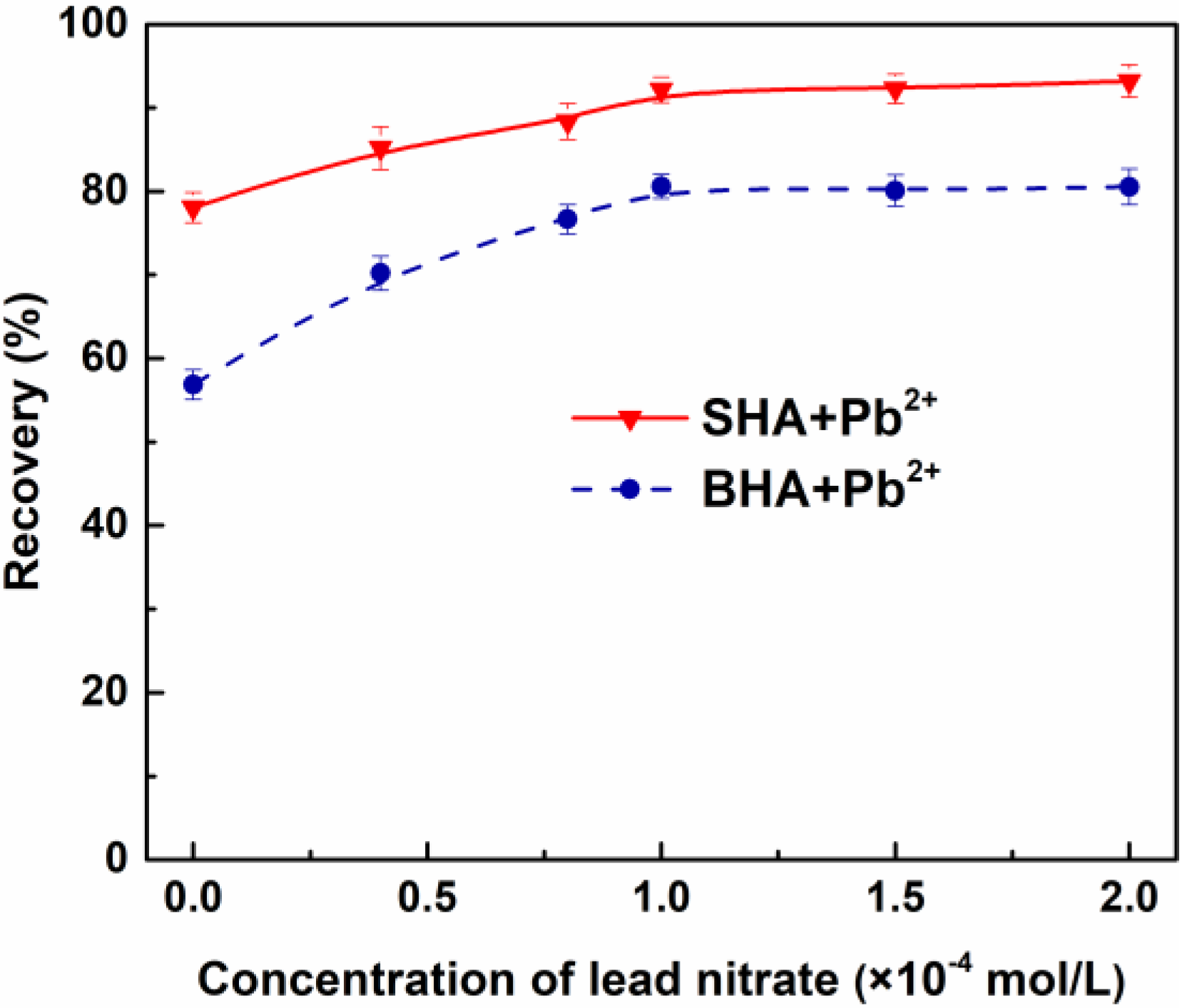
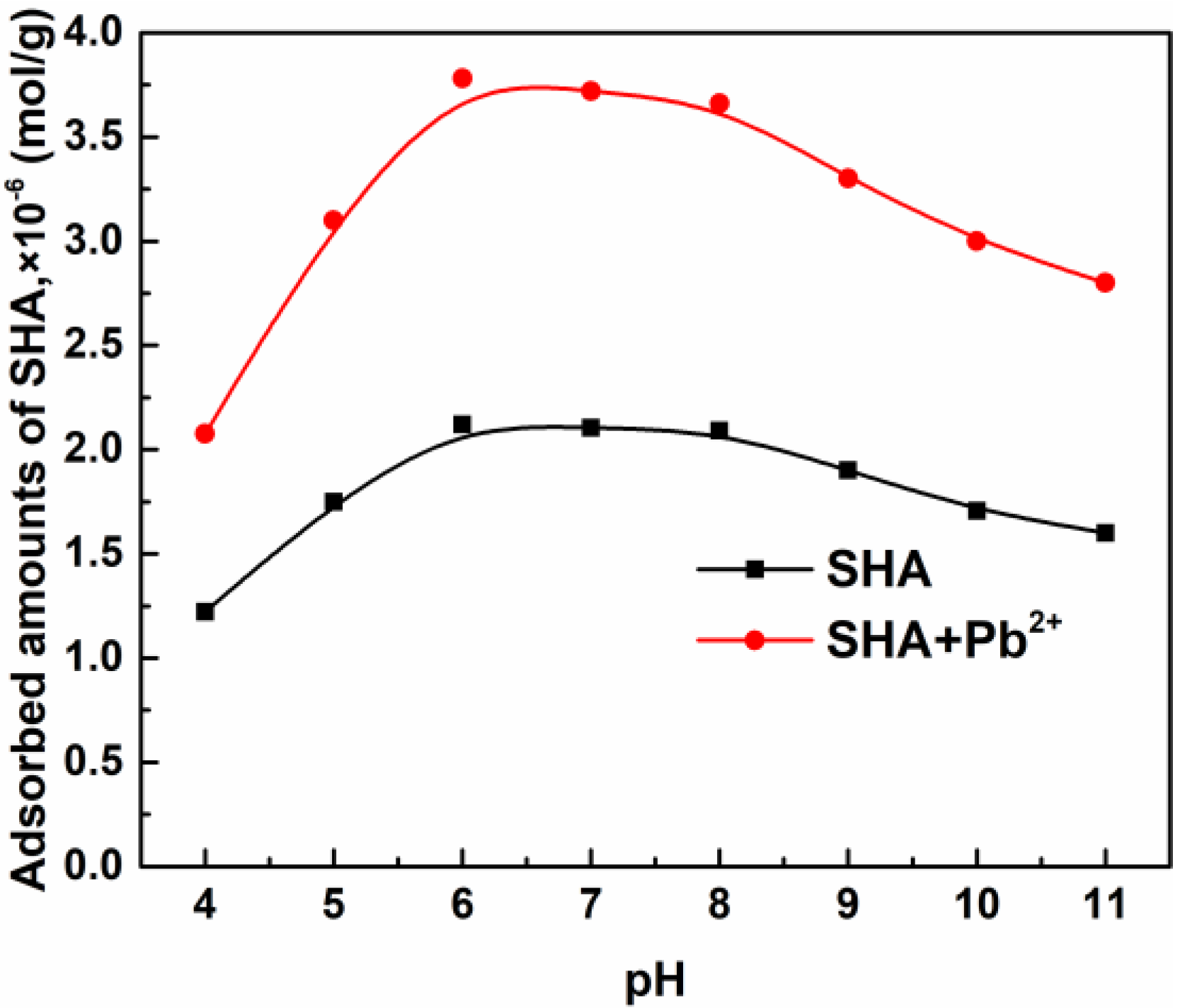

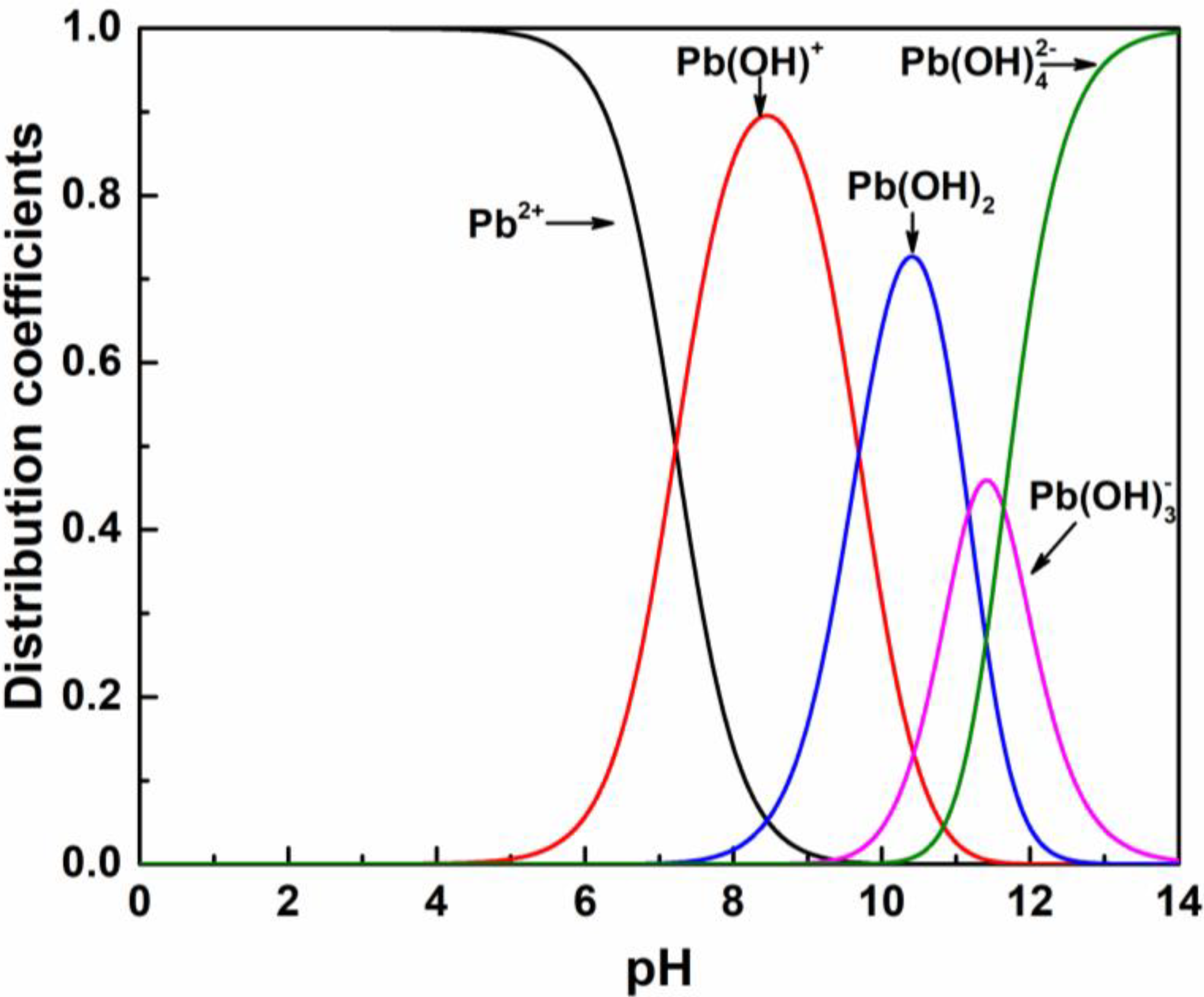

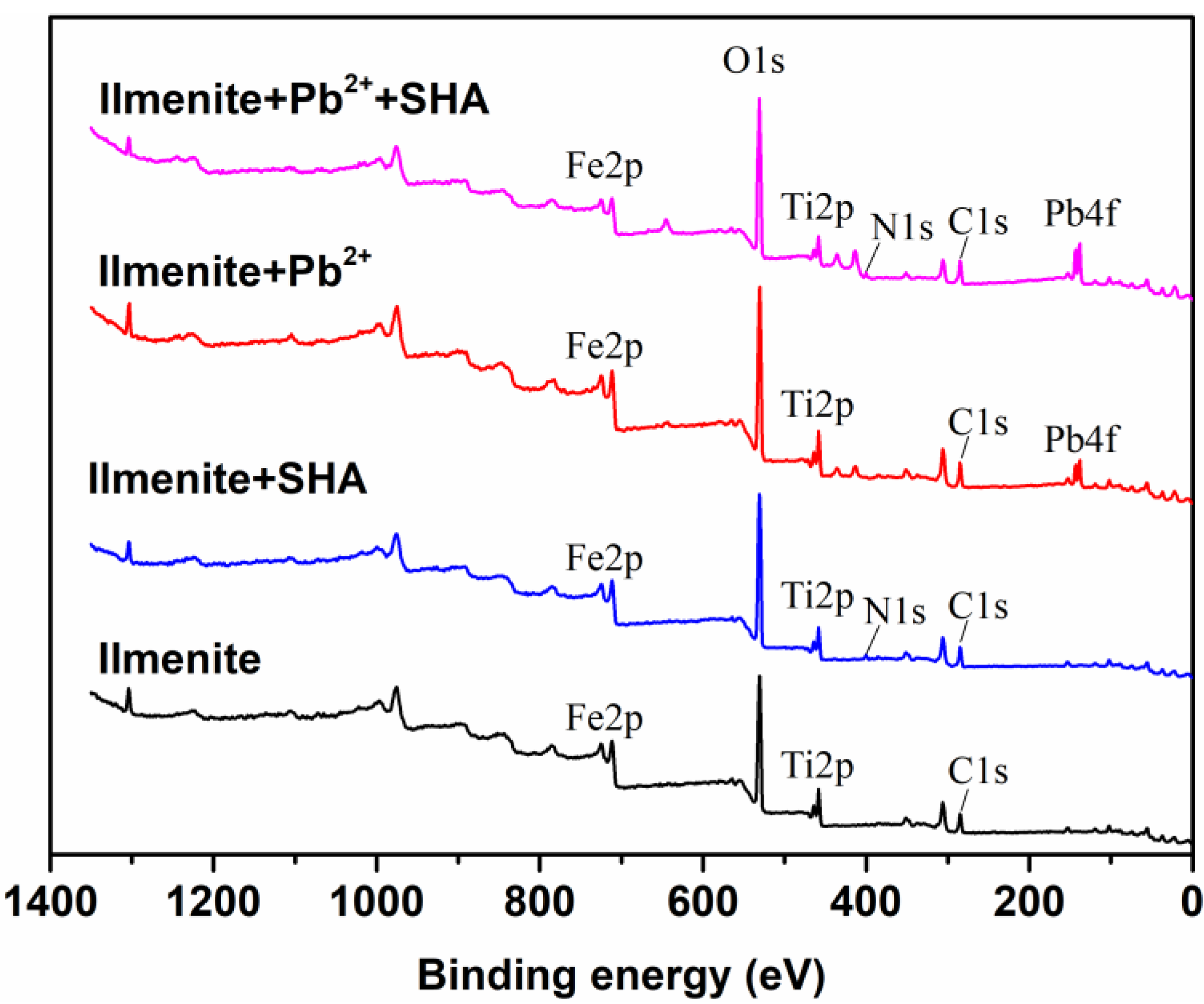
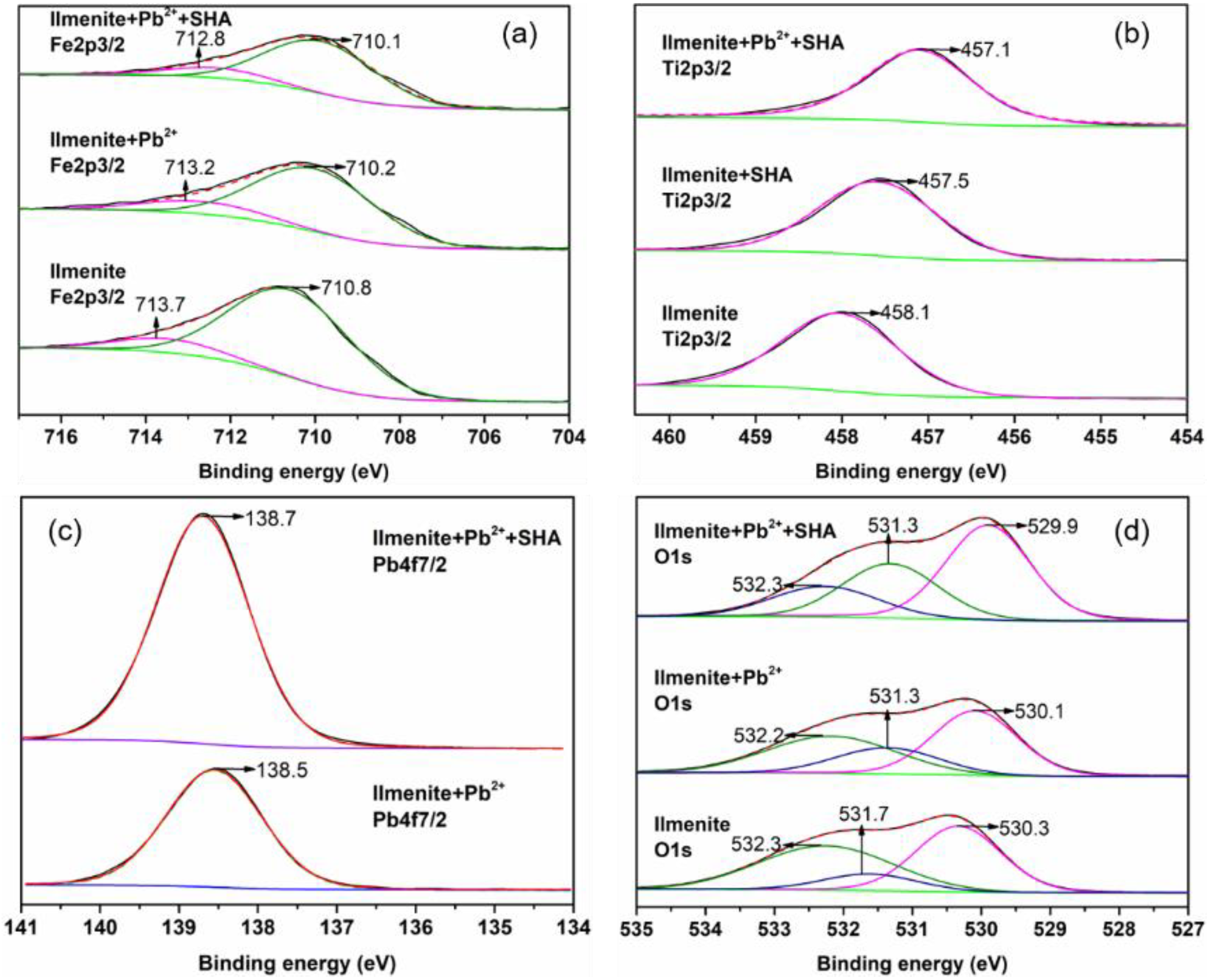

| Component | TiO2 | Fe2O3 | SiO2 | CaO | MgO | Al2O3 | MnO |
|---|---|---|---|---|---|---|---|
| Content (%) | 50.97 | 41.79 | 1.96 | 1.48 | 2.17 | 0.89 | 0.74 |
| Samples | Element (%) | |||||
|---|---|---|---|---|---|---|
| C(1s) | Ti(2p) | Fe(2p) | O(1s) | Pb(4f) | N(1s) | |
| Ilmenite | 45.00 | 11.44 | 6.33 | 37.23 | - | - |
| Ilmenite + SHA | 45.77 | 10.27 | 6.03 | 37.31 | - | 0.62 |
| Ilmenite + Pb2+ | 44.81 | 10.21 | 5.96 | 37.59 | 1.43 | - |
| Ilmenite + Pb2+ + SHA | 46.13 | 8.25 | 4.05 | 37.96 | 2.4 | 1.21 |
| Sample | Binding Energy (eV) | Assignment | Area Ratio (%) |
|---|---|---|---|
| Ilmenite | 530.3 | Ti–O | 43.37 |
| 531.7 | Fe–O | 11.67 | |
| 532.3 | H–O | 44.96 | |
| Ilmenite+Pb2+ | 530.1 | Ti–O | 56.30 |
| 531.3 | Fe–O | 15.42 | |
| 532.2 | H–O | 28.28 | |
| Ilmenite+Pb2++SHA | 529.9 | Ti–O | 50.16 |
| 531.3 | Fe–O | 30.40 | |
| 532.3 | H–O | 19.44 |
© 2020 by the authors. Licensee MDPI, Basel, Switzerland. This article is an open access article distributed under the terms and conditions of the Creative Commons Attribution (CC BY) license (http://creativecommons.org/licenses/by/4.0/).
Share and Cite
Liu, H.; Zhao, W.; Zhai, J.; Lu, X.; Chen, P.; Ren, X.; Sun, W.; Zhang, C.; Chen, W.; Wan, S. Activation Mechanism of Lead(II) to Ilmenite Flotation Using Salicylhydroxamic Acid as Collector. Minerals 2020, 10, 567. https://doi.org/10.3390/min10060567
Liu H, Zhao W, Zhai J, Lu X, Chen P, Ren X, Sun W, Zhang C, Chen W, Wan S. Activation Mechanism of Lead(II) to Ilmenite Flotation Using Salicylhydroxamic Acid as Collector. Minerals. 2020; 10(6):567. https://doi.org/10.3390/min10060567
Chicago/Turabian StyleLiu, Hang, Wenqing Zhao, Jihua Zhai, Xiaolong Lu, Pan Chen, Xi Ren, Wei Sun, Chenyang Zhang, Wei Chen, and Si Wan. 2020. "Activation Mechanism of Lead(II) to Ilmenite Flotation Using Salicylhydroxamic Acid as Collector" Minerals 10, no. 6: 567. https://doi.org/10.3390/min10060567




